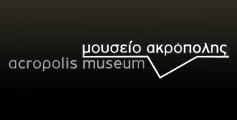|
|
About Parthenon
| The Parthenon |
 |
|
The Parthenon was the first and most important monument of the Periclean program on the Acropolis in classical times. It was a wondrous building because of its proportions and its excellent construction, but also because of the brilliant setting on the height of the Sacred Rock. A temple of Pentelic marble, Doric with Ionic features, it is unsurpassed not only in regard to its architecture and sculpture but also to the speed of construction.
The Parthenon was built from 447 to 438 B.C. by the architects Ictinus and Callicrates. The famous sculptor Phidias had general responsibility for supervising the entire project. Six years after the completion of the temple, the temple sculptures were also finished.
|
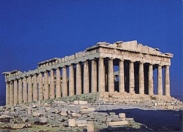
General view of the Parthenon from the northwest.
|
| Architecture |
 |
|
The Parthenon was a double temple, octastyle, peripteral with a hexastyle amphiprostyle cella. It was enormous, being some 70 meters long, 31 meters wide and 15 meters high. The Doric columns around the exterior had a lower diameter of 1.91 meters and they were 10.50 meters high. Some 16.500 architectural pieces of marble went into the construction of the building and they were all perfectly joined to each other.
The temple is defined as peripteral because it was surrounded by a «pteron»; in other words it had four colonnades. It is called octastyle because at each end it had eight columns. The long sides had seventeen. Thus the exterior colonnade had a total of forty-six columns. The east end was the front of the temple.
The cella is the closed space which housed the great statue of the goddess. The temple is characterised as double because the cella was divided into two separate compartments, one at the east and one at the west, which did not communicate with each other. In the eastern room a two-tiered Doric colonnade, Π-shaped in plan, enclosed the statue and supported the roof. The roof over the western room was supported by four very tall Ionic columns.
At each end, within the «pteron», there was a second row of columns, likewise Doric, known as the prostasis, with six columns. The temple thus had in its exterior a total of 46 + 12 = 58 columns. The space between the east prostasis and the cella forms the pronaos or east portico; the corresponding space at the west is the opisthonaos or rear portico.
The roof of the temple was made of wood and it was covered by marble tiles. The peripteral colonnades, the pronaos and opisthonaos all had marble ceilings of large horizontal blocks, with coffers, square sunken panels with border mouldings of double curvature (cymatia) and a painted decoration in the centre.
|
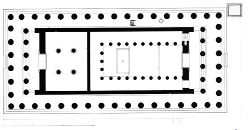
Plan of the Parthenon, drawing by M.Korres.
|
| Sculpture |
 |
|
The wealth of the sculptural adornment of the temple is unique. All the surfaces which, depending on their architectural composition, could be decorated, had sculptural decoration.
In the cella the great gold and ivory statue of the Athena Parthenos, 13 metres high, was considered a masterpiece; the statue was framed by a two-tiered colonnade of Doric columns supporting the roof with its marble tiles.
The unprecedented sculptural ensembles of the unique temple comprised: the east pediment with the birth of Athena; the west pediment with the contest between Athena and Poseidon for the privilege of being the patron of the city; the 92 metope reliefs with the Battle of the Giants, the Sack of Troy, the Amazonomachy and the Centauromachy on the east, north, west and south sides; and the Ionic frieze around the walls and the inner porches, 160 m. long, representing the Panathenaic procession.
On the long sides the tiles ended in a series of antefixes in the form of an anthemion. Lion-head pseudo-spouts decorated each of the four corners of the roof.
At the two ends and on the top of each pediment were the acroteria; statues in the round at the ends, with an enormous and finely carved anthemion between them at the apex.
|
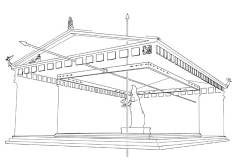
Diagram of the location of the Parthenon sculptures, drawing by M. Korres.
|
| The statue |
 |
|
Within the temple reigned a colossal, chryselephantine statue of the goddess Athena, rising together with its base to approximately 13 m. in height. It was the work of Pheidias. We can have only an idea of this splendid statue from small Roman copies. The goddess, standing, wore a long peplos and the aigis, adorned with the apotropaic head of the Gorgon Medusa. On her head she wore a skilfully conceived helmet, richly decorated with mythological beasts. She held the statue of the goddess Nike on her right hand, and with her left, her shield which rested upright on the ground. Her spear stood on the ground propped against her left shoulder. Favorite myths were depicted on various parts of the statue. Depicted in relief on the exterior of the shield was the Amazonomachy; painted on the interior, the Gigantomachy was shown. Scenes in relief on the sides of her sandals were drawn from the Centauromachy. Finally, the base of the statue was decorated in relief with a representation of the Birth of Pandora.
|
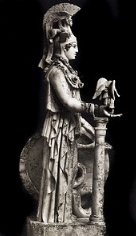
The "Varvakeion Athena", Roman copy of the statue of Athena Parthenos (2nd century A.C.). Athens, National Archaelogical Museum.
|
| Pediments |
 |
|
The pediments, the triangular spaces formed by the horizontal and raking cornices of the roof at each end of the temple, were the last parts of the building to receive sculptural decoration (437-432 B.C.), which comprised colossal statues in the round.
The themes were drawn from Attic mythology. The east pediment, over the entrance to the temple, depicted the birth of the goddess Athena from the head of her father, Zeus, in the presence of the Olympian divinities.
The composition gives an impression of symmetry even though there is no strict equivalence between the figures right and left of the main axis where the central figure of Zeus is placed. Next to him come Athena and Hephaistos, god of fire and smith of the gods, who, according to the myth, opened the head of Zeus with an axe so that the goddess could be born. Sitting next to Zeus are also Hera, his wife and goddess of marriage, Poseidon, Hermes, the messenger god, Ares, god of war, Apollo, god of light and music and Artemis, his sister, goddess of hunting. Hera wears a peplos, Athena is distinguished by her helmet and Apollo by his lyre.
The scene of the birth of Athena is framed at the two ends of the pediment by the figures of the rising Sun (Helios) and the setting Moon (Selene), showing that her birth took place at dawn.
To the left, Dionysos, god of wine, lying nude, with godly serenity, holds a vessel. Next are Demeter, goddess of agriculture, and her daughter, Kore or Persephone, wife of Pluto, king of the Underworld, seated on cube-like cases. Demeter is turning toward the scene of birth, while talking to Kore who looks straight ahead. Their poses are entirely natural and yet they fit harmoniously into the pedimental composition.
To the right, there is a group of three seated goddesses, Hestia, goddess of the hearth, Dione and her beautiful daughter Aphrodite, goddess of love, who stretches out languidly in her mother’s arms. The whole atmosphere breathes peace and the serenity of the Olympian divinities. These magnificent statues depict a myth that is directly connected with the goddess who is protectress of the city.
In the west pediment was shown the contest between the goddess Athena and the god Poseidon for possession of the land of Attica, a contest won by Athena who became the guardian (poliouchos) of the city of Athens.
Left and right of the centre, the two divinities, Athena and Poseidon, compose a V with their bodies pulling away from the axis. They are framed by the two chariots that brought them to the contest, with Nike and Poseidon’s wife, Amphitrite, respectively, as charioteers; they ride on waves. Together with the bronze thunderbolt of Zeus they show that the moment depicted is when Zeus interferes to stop the deluge.
Athena has a spear and helmet, and she wears a peplos with the aegis obliquely across her breast. The olive tree which has sprung up beside her is of bronze. Poseidon holds his trident and is represented nude. The antithetical movement of the two central figures is brought into balance by the two pairs of horses, which the charioteers are with difficulty trying to hold in check.
Behind the chariots, the two messengers are depicted, Iris, on one side with Poseidon; and Hermes on the other side near Athena. They are coming to announce the desire of Zeus that the contest and the flood be ended. In the north angle is Kekrops and his daughter, Pandrossos. The child next to him is his son, Erysichthon. Sitting in the south angle is Oreithyia, the daughter of Erechtheus. She was married to the north wind, Boreas, and in the pediment her twin sons, Zetes and Kalais are beside her.
The half reclining figures in the two corners are personifications of the river Kephissos and the Kallirrhoe spring. Kallirrhoe is shown reclining on a rock, looking toward the contest of the deities in the centre. Beside her, shown nude, sits Ilissos, the other Attic river.
|

K. Schwerzek, Recontruction of the east pediment. Acropolis Museum.
|

K. Schwerzek, Recontruction of the west pediment. Acropolis Museum.
|
| Metopes |
 |
|
The frieze or diazoma of the Doric temple, which encircles the entire building between the architrave and the overlying cornice, is comprised of alternating triglyphs and metopes. On the Parthenon, all the metopes are decorated with sculpture, an arrangement that is unique in ancient Greek architecture.Their relief is so high that if the temple were to be viewed directly from that height the triglyphs would not be discernible and the relief would appear to be continuous.
The ninety-two metopes were the first of the sculptural decoration to be made for the temple. They were carved on the ground by different teams of sculptors and stone-cutters, who undertook the work in separate teams. Among them were also metics, (resident aliens) who had come to Athens mainly from the Aegean islands. This explains the slight differences of style in the metopes.
The themes of the reliefs in the metopes are drawn from Greek mythology. Most, indeed, depict a favorite subject in ancient Greek art, the contest.
Visible on the east side, the most important view of the great temple, were scenes from the Gigantomachy, the mythical battle between the gods of Olympos and the Giants, who tried to upset the order of the world.
At the other end, at the west, were scenes of the Amazonomachy. The Greeks, with their hero Theseus, confronted the Amazons, a barbarian tribe of female warriors who according to myth lived somewhere in the Pontos, (in the region of the Black Sea).
Depicted on the north side were scenes from the Trojan War, mainly the conquest and destruction of Troy by the Achaean Greeks, a theme known as the Ilioupersis.
On the south side, twenty-three metopes are devoted to the Centauromachy, while the other nine, in the middle, have yet another subject. The Thessalian Lapiths invited their neighbors the Centaurs to the wedding of their king Peirithoös. The Centaurs, so says the myth, were a barbaric tribe with the body of a horse and the torso and head of a man. At the wedding the Centaurs became drunk and tried to make off with the Lapith women, so that a hand to hand battle ensued. For the Greeks, the Centauromachy signified the confrontation of civilisation and logic with barbarity.
Thus on the metopes of the Parthenon there are four main themes that are known from the sculpture of many other Greek temples as well as from various other works of art. The themes are connected with the Contest, the Struggle, between two adversaries, whoever they may be. This expression of the Contest is unsurpassed and stands as a symbol of the eternal fight between the opposing and counterpoised forces in nature, in human society and in the human soul. In essence the Struggle is indecisive and is therefore without end. The outcome itself is thus of little importance compared to the process. The deep meaning of the work bespeaks the maturity of the society that created it and its intellectual distance from the art of its neighbours in which the closest theme is concerned solely with a struggle always won, and with the humbling of the defeated enemy.
|
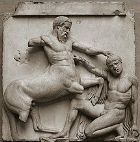
South metope 30. British Museum.
|
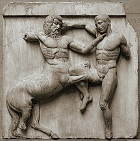
South metope 31. British Museum.
|
| Frieze |
 |
The frieze of the Parthenon forms a continuous band with scenes in relief that encircles the upper part of the cella, the main temple, within the outer colonnade. The theme represented was the procession toward the Acropolis that took place during the Great Panathenaia, the festival in honour of the goddess Athena.
More information....
© 2009 Ministry of Culture – Acropolis Restoration Service – First Ephorate of Prehistoric and Classical Antiquities – Department of Information and Education
© 2009 National Documentation Centre-National Hellenic Research Foundation
Reprinting of all or part, republication or reproduction of photographs and/or text in any form whatsoever without written permission of the holders of the copyright is strictly forbidden.
|



